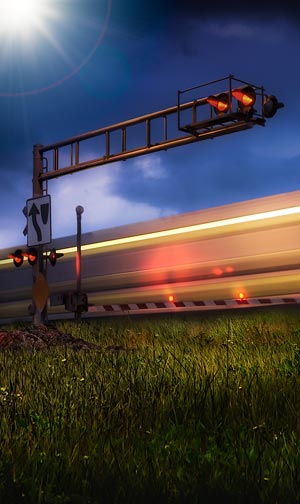Wichita Pedestrian Killed by BNSF Train While Traversing Railroad Crossing
(Wichita, Kansas – August 7, 2013)
Mystery continues to surround the tragic death of a 26-year-old male pedestrian, killed during rush hour (about 5:15 pm) Wednesday afternoon when he was struck by an 86-car train. The incident occurred at a heavily-traveled Wichita, KS intersection of parallel BNSF railroad tracks and highway with a perpendicular and equally busy thoroughfare on the city’s south side.
Robert L. Wells of Wichita was the lone casualty of the collision, which police said did not involve drugs, alcohol, physical disability, headphones, use of a cell phone, or suicide. Although Wichita Police are still investigating with influential assistance from Burlington Northern Santa Fe Railway Police, so many factors point to an extremely dangerous intersection, equipped with a multiplicity of interrelated and confusing signalization for railroad, highway and pedestrian traffic. Essentially for pedestrian traffic the rule is a “fend for yourselves.” There are no separate warning gates or signals for pedestrians, even though both the South Hydraulic and adjacent East Pawnee Street crossings of BNSF tracks have flashing lights, gates and bells to signal motorists of approaching trains. But the crossings are so convoluted it is difficult to determine which warning systems apply to whom. Not only do BNSF freight trains use the crossings, but Union Pacific does as well, via trackage rights, and should Amtrak service ever extend to Oklahoma City, as has been proposed, another pair of higher-speed trains could become part of the equation.
A daily average of 33 trains daily now cross the double intersection at a top speed of 45 mph, according to Federal Railroad Administration-kept and railroad and KDOT-generated records, and a daily average of 5,824 motor vehicles cross the tracks at Hydraulic, where Wednesday’s tragedy was the first fatality out of a total of four accidents recorded there. No records of average pedestrian traffic are maintained by any railroad or agency, but the same numbers of trains traveling at the same 45 mph speed restriction intersect the traffic of another 19,006 highway vehicles daily at the Pawnee Street crossing, barely a block away. A total of eight accidents, two resulting in injury but no fatalities, have been suffered there.
Add these factors to the directly-parallel traffic on Southwest Boulevard to the BNSF/UPRR rail line and the situation is one of “Heaven help us!” as motorists run the same routes as the trains without crossing the tracks, or divert their paths at either Hydraulic (a north-south thoroughfare) or the east-west traffic pattern of Pawnee. The three main streets form a triangulation which, when added to the railroad route (which was there first) result in virtual traffic strangulation. Now throw pedestrians into the mix and the situation becomes close to chaotic.
Wichita Police say that the victim was walking north on Hydraulic and that it appeared he never saw the approaching train until it was too late to take diversionary action. Police say that Wells was three-quarters of the way across the double-track rail line when he may have noticed the oncoming train, as he seemed to turn his attention at that point.
As might be expected, convolution of the factors can often result in confusing advice from responding safety agencies and representatives. “Only thing I would say is, it’s very important that people stay off the railroad right-of-ways and when you’re going across, when you’re walking across railroad tracks, you need to be paying attention and looking to make sure that there’s not a train coming,” Lt. Joe Schroeder of the Wichita Police Dept. told KSN-TV reporter Ryan Newton. “They (the trains) cannot stop and there’s nothing that can be done when you do that.”


